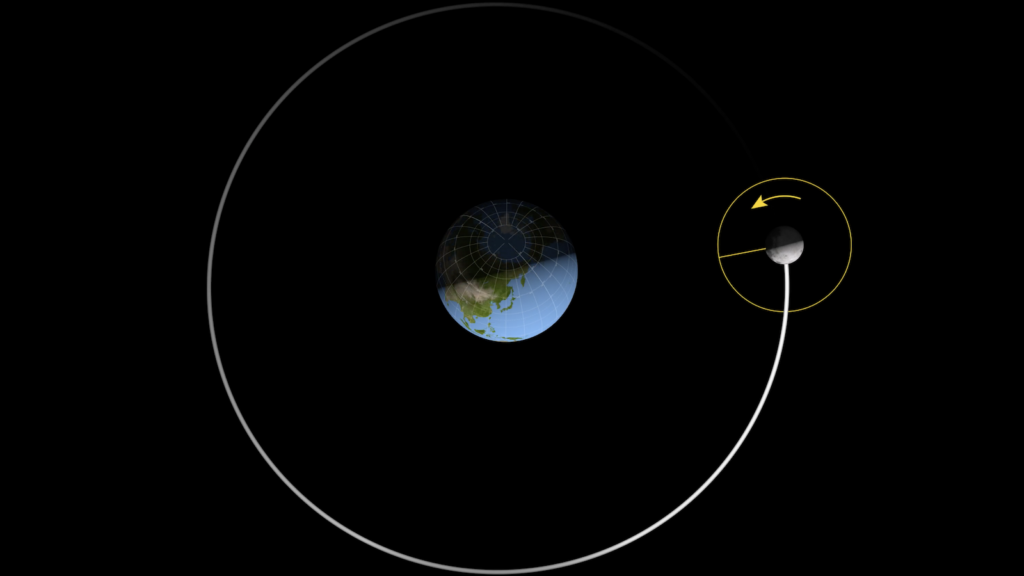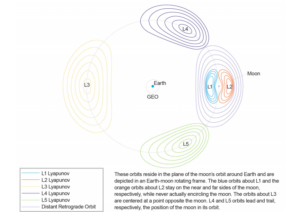
Operating in space beyond Earth’s orbit all the way out to the Moon and beyond presents Space Force with complex problems. (Image: NASA)
Updated April 22, 2022 at 9:30 am to include Space Force response.
WASHINGTON: Space Systems Command is launching new efforts to help Space Force monitor the vast volumes of space beyond the Moon, Mars and eventually even farther, officials said this week.
Lt. Col. Matt Lintker, who commands the 18th Space Defense (formerly Control) Squadron that currently is charged with monitoring near-Earth space, told the C4ISRNet conference on Wednesday that the service now has stood up a new 19th Space Defense Squadron with the mission of tracking what Space Force officials now refer to as “xGEO” space.
Geosynchronous Orbit (GEO) is essentially the outer orbit of Earth, some 36,000 kilometers above sea level. The new 19th Space Defense Squadron, with its “xGEO” remit, would have oversight over everything beyond that, including cislunar space, or the area around the Moon. Cislunar is seen as particularly fertile ground for future satellites, thanks to the benefit of Lagrange points, positions in space where, due to the gravitational pulls of nearby celestial bodies, objects essentially tend to stay put.
Lintker said the new squadron, which like the 18th will reside under Space Force Delta 2, will be located at Dahlgren Naval Base in Virginia.
Delta 2 is one of the service’s eight mission-focused elements under Space Operations Command. Delta 2 “prepares, and presents assigned and attached forces for the purpose of executing combat-ready Space Domain Awareness (SDA) operations to deter aggression and, if necessary, fight to protect and defend the U.S. and our allies from attack in, through and from space,” according to the unit’s website.
Mike Pierson, chief of public affairs at Space Operations Command, told Breaking Defense in an email that the Space Force stood up the new squadron on April 6 to replace the 18th Space Defense Squadron’s Detachment 1.
It’s mission statement, he said, is as follows: “The 19 SDS is responsible for providing continuous Space Domain Awareness (SDA) for government, civilian, and international users and to maintain continuous and transparent SDA to assure global freedom of action in space.”
“Our goal is to provide foundational SDA in all regimes,” Pierson explained. “Currently, we don’t have sensors or systems with dedicated XGEO mission responsibility. However, we are keenly interested in innovative approaches to ensure freedom of access and understanding for the US and our allies in all orbital regimes, including beyond GEO.”
Many in US national security space circles have been increasingly concerned that in the not too distant future the rush for commercial and civil exploration and exploitation on and around the Moon, Mars and in the asteroid belt could result in military threats. In particular, Defense Department leadership is casting a wary eye on China’s exploration and exploitation plans, due to the fact that the blood/brain barrier between the People’s Liberation Army and Beijing’s civil space program is extremely porous.
Meanwhile, the service’s acquisition arm, Space Systems Command (SSC), is planning to hold a show-and-tell for industry where companies can present their technology and skills for monitoring space activities in cislunar space.
“Here this summer we’re going to have an industry day — we actually called it a ‘reverse industry day’ and I’ll tell you what that is in a second — focused on cislunar space situational awareness,” SSC Commander Lt. Gen. Micheal Guetlein told the conference.
“But as we start to explore more and more of space, from a commercial as well as a government perspective, as you see NASA doing, we’re going to need better situational awareness going out there,” he said.” And we’re currently looking across the board on how to get there.”
Guetlein explained that under the “reverse industry day” concept, SSC will gather “all our program managers and program executive officers” and invite interested companies to “come in and pitch what they can currently provide” to help Space Force with space domain awareness.
This will allow SSC to figure out what it can simply acquire commercially, and what it will need to build to order to be able to keep tabs on spacecraft, space junk and even meteoroids in cislunar space, he added.
“Industry has enormous amounts of intellectual capital and proprietary data that they aren’t necessarily willing to disclose in front of others. I’m trying to provide them that safe space to bring that data and those ideas to the government to try to help us solve our future problems,” Guetlein said.

Cislunar Lagrange points (Aerospace Corp. image)
Lintker said that conducting deep space activities isn’t as simple as doing what operators do in space around the Earth. That’s because the physics of deep space are different than those that apply to near-Earth orbit.
“The challenge for us is the math and the potential options are different,” Lintker elaborated. “As we look at what we’re historically aligned to within Low Earth Orbit, and Geosynchronous Orbit, it’s Keplerian orbital dynamics. So it’s a two-body problem. As you start to get out past Geosynchronous Orbit, it no longer becomes just a two-body problem.”
Those physics problems involving navigation in space where three or more celestial bodies are all exerting gravitational pull will, assuredly, be complicated and difficult to solve.






















